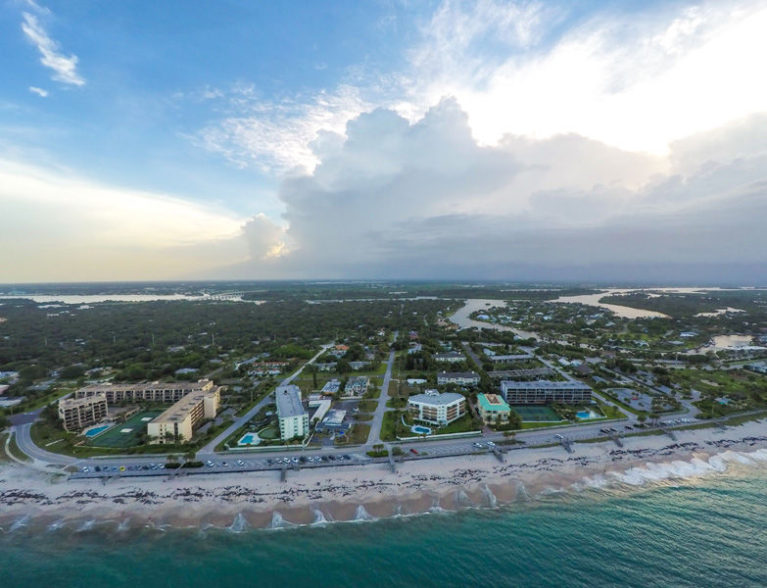
INDIAN RIVER COUNTY — You know what local lifeguards do when they see a shark moving toward the bathing area at the beach? They blow their whistles, order everyone out of the water and close the beach for the next 30 to 60 minutes.
You know what local lifeguards do on those rare occasions when they see someone actually get bit by a shark?
“We go get them,” Vero Beach lifeguard Vincent Valentino said.
Even though the shark might still be nearby?
“It doesn’t stop us from going into the water,” Valentino said. “If someone is in trouble, we go get them – yeah, even if a shark is out there.”
And if you’ve been watching the news lately, you know predatory sharks are out there, with regular sightings along the Treasure Coast and a couple of bathers bitten off the beaches of Brevard County.
During the past few weeks, in fact, there have been shark-related closures of varying durations at several area beaches, mostly in St. Lucie County but also in the Vero area.
Erik Toomsoo, president of the Vero Beach Lifeguard Association, said the city’s three beaches “frequently” close for half-hour intervals at this time of year – as often as once per day last week – when sharks tend to follow mullet and tarpon closer to the shoreline.
“When we see a shark get too close, we put up the double red flags and close for 30 minutes and wait for him to move on,” Toomsoo said. “If he hangs around, we’ll keep it closed longer. But it’s really nothing unusual for this time of year.
“We’ve had a few closures recently, but we haven’t any bites,” he added. “So we’re probably due for one.”
Doesn’t matter: The lifeguards continue to do their jobs, which require them to go into the water to swim, train and, yes, perform rescues.
All the recent shark sightings in the area have put them on a higher level of alert, but the lifeguards say the threat goes with the territory.
“It’s the ocean,” Valentino said. “There are sharks out there every day. I don’t worry about it, at least as far as the job goes. It certainly doesn’t change what we do.
“lf you get bit by a shark, you’re just in the wrong place at the wrong time.”
Or as Toomsoo put it: “You’re in more danger driving to the beach in your car than you are of being attacked by a shark when you get here.”
Shark attacks at Indian River County beaches have been rare. According to the University of Florida Museum of Natural History, which has been tracking shark bites in the state since 1882, there have been only 18 unprovoked attacks here.
Only one was fatal.
A 12-year-old boy got “nipped” in the leg near the Windsor Club on New Year’s Day. As of Monday, that’s the only shark attack in the county this year.
Not since November 2013, when Peruvian tourist Daniel Vargas was attacked 100 yards off shore at South Beach and had his Achilles tendon severed, has there been a serious shark bite, locally.
Eighteen months earlier, German tourist Karin Stei was only 30 yards out – standing in waist-deep water – when she suffered life-threatening injuries from a shark attack north of Humiston Beach Park.
The bite, probably from a bull shark or tiger shark, removed a large section of her left thigh, down to the bone.
Stei was rescued by Toomsoo, who received the United States Lifesaving Association’s Medal of Valor for his efforts in saving her life.
Toomsoo knew the shark might still be in the vicinity when he entered the water on that fateful May morning.
“Just the nature of our business,” he said.
Valentino and fellow lifeguard Stephen Harkness said they weren’t specifically trained to locate predatory sharks as they scan the water off the coast from their towers.
“It comes with experience,” Harkness said. “When the water is clear, like it’s been lately, you can see the shadows as they come in. And with all the shark sightings up and down the coast, we’re looking for them.
“We’ve got a pretty good view from up here.”
Valentino said there have been only a few sightings in the Vero Beach area the past couple of weeks, but lifeguards are getting plenty of shark questions from beach goers.
“Everybody’s asking about it, but that’s not surprising,” Valentino said. “It’s been on the news and there are shark videos all over social media, so people want to know what’s going on. But they’re still going in the water.”
The lifeguards said beachgoers should avoid the water in early morning and late afternoon – the times of day when sharks are more likely to swim closer to shore.
“Sunrise and sunset are bad times, because the angle of the sun changes and the prey at the surface is more visible,” Harkness said. “You also need to be aware of bait fish. When they swim in, predators are going to follow.”
Lifeguards, of course, don’t have that luxury. The ocean is part of their workplace. Swimming with sharks is part of the job.
“We’ve all been bumped,” Harkness said.
As for confronting a shark during a rescue, the lifeguards said they haven’t been trained for that, either. However, they said they’d try to drive off the predator by punching him in the nose, gouging his eyes and hitting them in the gills.
That is, if they see the shark coming.
“Sharks are pretty quick, so you’re never 100 percent in the clear,” Valentino said. “Most shark-bite victims will tell you they never saw the shark.”



